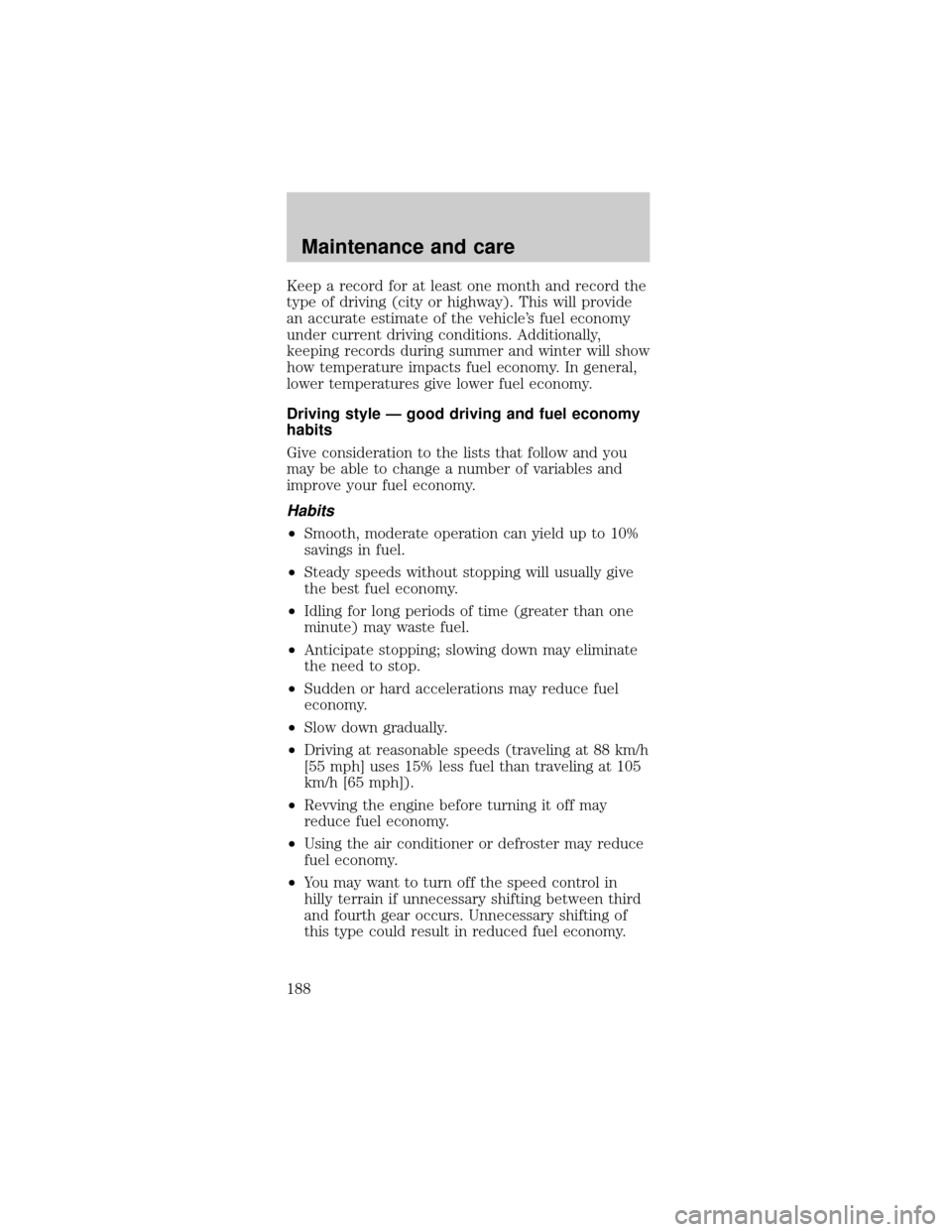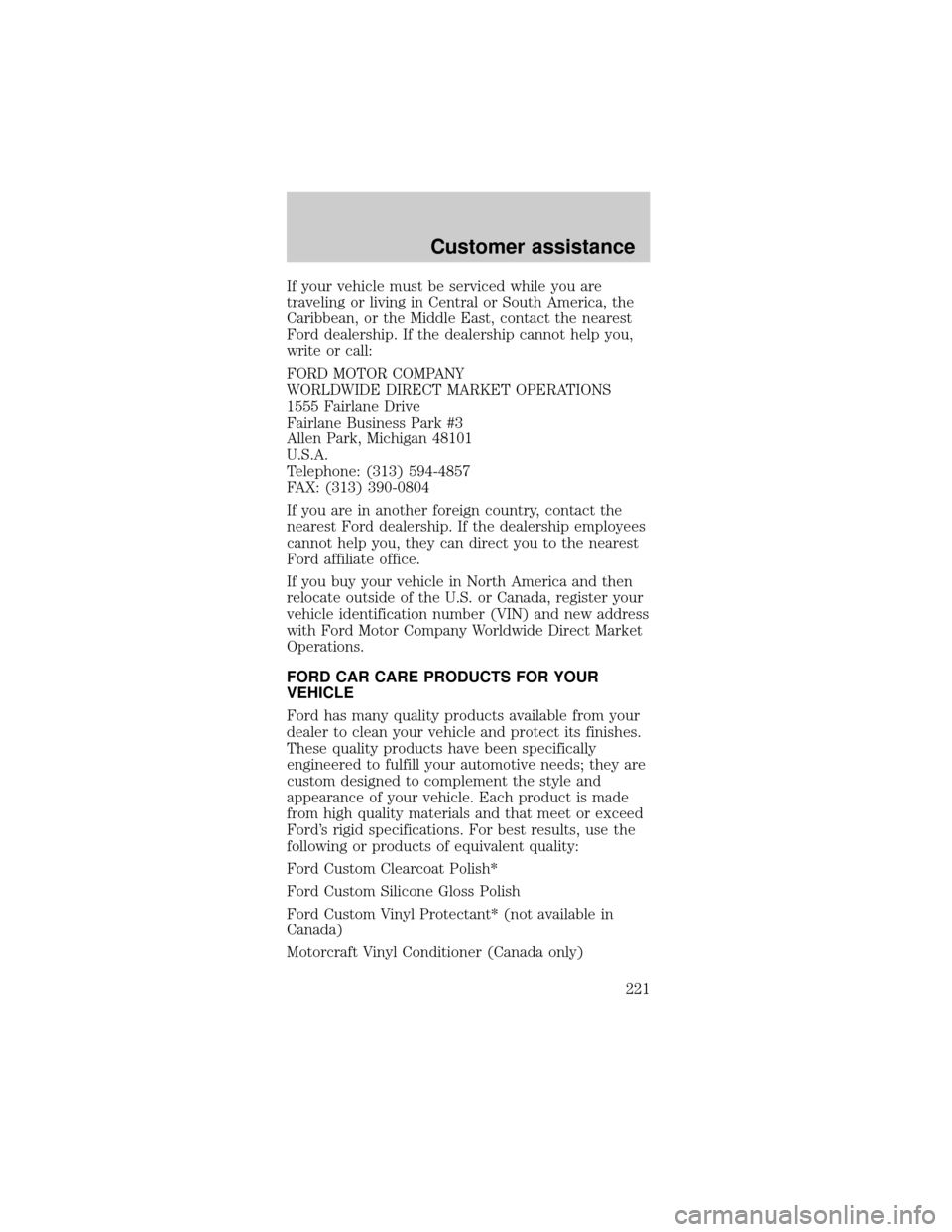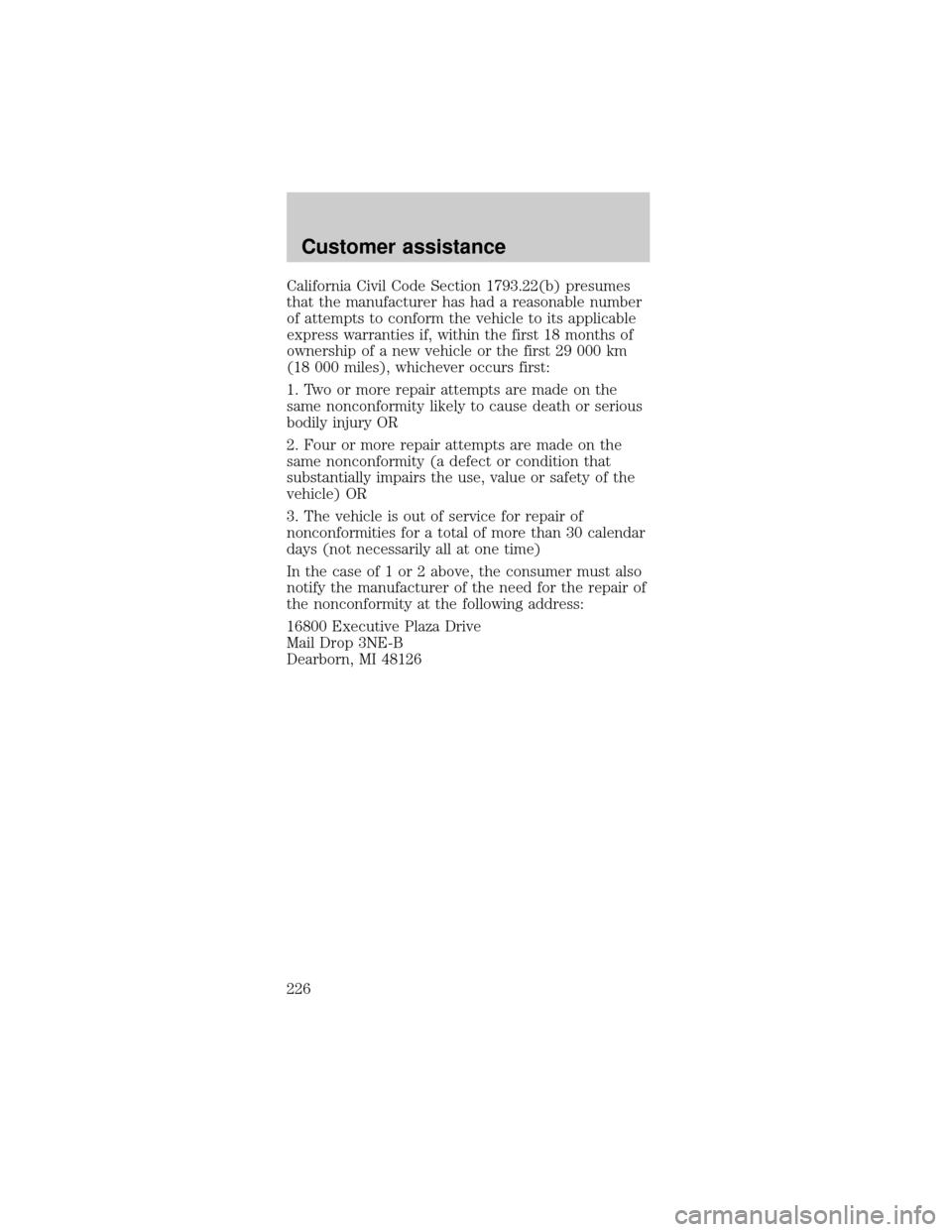2001 FORD MUSTANG air condition
[x] Cancel search: air conditionPage 127 of 240

Trailer towing tips
²Practice turning, stopping and backing up before
starting on a trip to get the feel of the vehicle
trailer combination. When turning, make wider
turns so the trailer wheels will clear curbs and
other obstacles.
²Allow more distance for stopping with a trailer
attached.
²The trailer tongue weight should be 10% of the
loaded trailer weight.
²After you have traveled 80 km (50 miles),
thoroughly check your hitch, electrical
connections and trailer wheel lug nuts.
²When stopped in traffic for long periods of time in
hot weather, place the gearshift in P (Park) and
increase idle speed. This aids engine cooling and
air conditioner efficiency.
²Vehicles with trailers should not be parked on a
grade. If you must park on a grade, place wheel
chocks under the trailer's wheels.
Recreational towing (all wheels on the ground)
Follow these guidelines for your specific powertrain
combination to tow your vehicle with all four wheels
on the ground (such as behind a recreational vehicle).
These guidelines are designed to ensure that your
transmission is not damaged due to insufficient
lubrication.
All Rear Wheel Drive (RWD) vehicles
This applies to all cars and 4x2 trucks/sport utilities
with rear wheel drive capability.
An example of recreational towing is towing your
vehicle behind a Motorhome. The following
recreational towing guidelines are designed to
ensure that your transmission is not damaged.
²Place the transmission in N (Neutral).
²Maximum speed is 56 km/h (35 mph).
²Maximum distance is 80 km (50 miles).
Driving
127
Page 147 of 240

SERVICE RECOMMENDATIONS
To help you service your vehicle:
²We highlight do-it-yourself items in the engine
compartment for easy location.
²We provide a scheduled maintenance guide which
makes tracking routine service easy.
If your vehicle requires professional service, your
dealership can provide the necessary parts and
service. Check yourWarranty Guideto find out
which parts and services are covered.
Use only recommended fuels, lubricants, fluids and
service parts conforming to specifications. Motorcraft
parts are designed and built to provide the best
performance in your vehicle.
PRECAUTIONS WHEN SERVICING YOUR
VEHICLE
Be especially careful when inspecting or servicing
your vehicle.
²Do not work on a hot engine.
²When the engine is running, keep loose clothing,
jewelry or long hair away from moving parts.
²Do not work on a vehicle with the engine running
in an enclosed space, unless you are sure you
have enough ventilation.
²Keep all lit cigarettes, open flames and other lit
material away from the battery and all fuel related
parts.
If you disconnect the battery, the engine must
ªrelearnº its idle conditions before your vehicle will
drive properly, as explained in theBatterysection in
this chapter.
Working with the engine off
²Automatic transmission:
1. Set the parking brake and ensure the gearshift is
securely latched in P (Park).
Maintenance and care
147
Page 184 of 240

Repairs to correct the effects of using a fuel for
which your vehicle was not designed may not be
covered by your warranty.
Octane recommendations
Your vehicle is
designed to use
ªRegularº unleaded
gasoline with pump
(R+M)/2 octane rating of 87. We do not recommend
the use of gasolines labeled as ªRegularº that are
sold with octane ratings of 86 or lower in high
altitude areas.
Do not be concerned if your engine sometimes
knocks lightly. However, if it knocks heavily under
most driving conditions while you are using fuel with
the recommended octane rating, see your dealer or
a qualified service technician to prevent any engine
damage.
Fuel quality
If you are experiencing starting, rough idle or
hesitation driveability problems during a cold start,
try a different brand of ªRegularº unleaded gasoline.
ªPremiumº unleaded gasoline is not recommended
(particularly in the United States) because it may
cause these problems to become more pronounced.
If the problems persist, see your dealer or a qualified
service technician.
It should not be necessary to add any aftermarket
products to your fuel tank if you continue to use
high quality fuel of the recommended octane rating.
Aftermarket products could cause damage to the
fuel system. Repairs to correct the effects of using
an aftermarket product in your fuel may not be
covered by your warranty.
87(R+M)/2 METHOD
Maintenance and care
184
Page 188 of 240

Keep a record for at least one month and record the
type of driving (city or highway). This will provide
an accurate estimate of the vehicle's fuel economy
under current driving conditions. Additionally,
keeping records during summer and winter will show
how temperature impacts fuel economy. In general,
lower temperatures give lower fuel economy.
Driving style Ð good driving and fuel economy
habits
Give consideration to the lists that follow and you
may be able to change a number of variables and
improve your fuel economy.
Habits
²Smooth, moderate operation can yield up to 10%
savings in fuel.
²Steady speeds without stopping will usually give
the best fuel economy.
²Idling for long periods of time (greater than one
minute) may waste fuel.
²Anticipate stopping; slowing down may eliminate
the need to stop.
²Sudden or hard accelerations may reduce fuel
economy.
²Slow down gradually.
²Driving at reasonable speeds (traveling at 88 km/h
[55 mph] uses 15% less fuel than traveling at 105
km/h [65 mph]).
²Revving the engine before turning it off may
reduce fuel economy.
²Using the air conditioner or defroster may reduce
fuel economy.
²You may want to turn off the speed control in
hilly terrain if unnecessary shifting between third
and fourth gear occurs. Unnecessary shifting of
this type could result in reduced fuel economy.
Maintenance and care
188
Page 200 of 240

Remove any exterior accessories, such as antennas,
before entering a car wash. If you have wax applied
to the vehicle at a commercial car wash, it is
recommended that you clean the wiper blades and
windshield as described inCleaning the wiper
blades and windshield.
After washing, apply the brakes several times to dry
them.
Underbody
Flush the complete underside of vehicle frequently.
Keep body drain holes unplugged. Inspect for road
damage.
Waxing your vehicle
Waxing your vehicle on a regular basis will reduce
minor scratches and paint damage.
Wax when water stops beading on the surface. This
could be every three or four months, depending on
operating conditions.
Use only carnauba or synthetic-based waxes. Use a
cleaning fluid with a clean cloth to remove any bugs
before waxing your vehicle. Use tar remover to
remove any tar spots.
Avoid getting wax on the windshield, or on any
surfaces which appear coarse or bumpy. If you have
wax applied at a commercial car wash, it is
recommended that you clean the wiper blades and
windshield as described inCleaning the wiper
blades and windshield.
Repairing paint chips
Minor scratches or paint damage from road debris
may be repaired with the Ultra Touch Prep and
Finishing Kit (F7AZ-19K507±BA), Lacquer Touch-up
Paint (ALBZ-19500±XXXXA), or Exterior Acrylic
Spray Lacquer (ALAZ-19500±XXXXA) from the Ford
Car Care Chemicals line. Please note that the part
numbers (shown as XXXX above) will vary with your
vehicle's specific coloring. Observe the application
instructions on the products.
Maintenance and care
200
Page 221 of 240

If your vehicle must be serviced while you are
traveling or living in Central or South America, the
Caribbean, or the Middle East, contact the nearest
Ford dealership. If the dealership cannot help you,
write or call:
FORD MOTOR COMPANY
WORLDWIDE DIRECT MARKET OPERATIONS
1555 Fairlane Drive
Fairlane Business Park #3
Allen Park, Michigan 48101
U.S.A.
Telephone: (313) 594-4857
FAX: (313) 390-0804
If you are in another foreign country, contact the
nearest Ford dealership. If the dealership employees
cannot help you, they can direct you to the nearest
Ford affiliate office.
If you buy your vehicle in North America and then
relocate outside of the U.S. or Canada, register your
vehicle identification number (VIN) and new address
with Ford Motor Company Worldwide Direct Market
Operations.
FORD CAR CARE PRODUCTS FOR YOUR
VEHICLE
Ford has many quality products available from your
dealer to clean your vehicle and protect its finishes.
These quality products have been specifically
engineered to fulfill your automotive needs; they are
custom designed to complement the style and
appearance of your vehicle. Each product is made
from high quality materials and that meet or exceed
Ford's rigid specifications. For best results, use the
following or products of equivalent quality:
Ford Custom Clearcoat Polish*
Ford Custom Silicone Gloss Polish
Ford Custom Vinyl Protectant* (not available in
Canada)
Motorcraft Vinyl Conditioner (Canada only)
Customer assistance
221
Page 226 of 240

California Civil Code Section 1793.22(b) presumes
that the manufacturer has had a reasonable number
of attempts to conform the vehicle to its applicable
express warranties if, within the first 18 months of
ownership of a new vehicle or the first 29 000 km
(18 000 miles), whichever occurs first:
1. Two or more repair attempts are made on the
same nonconformity likely to cause death or serious
bodily injury OR
2. Four or more repair attempts are made on the
same nonconformity (a defect or condition that
substantially impairs the use, value or safety of the
vehicle) OR
3. The vehicle is out of service for repair of
nonconformities for a total of more than 30 calendar
days (not necessarily all at one time)
In the case of 1 or 2 above, the consumer must also
notify the manufacturer of the need for the repair of
the nonconformity at the following address:
16800 Executive Plaza Drive
Mail Drop 3NE-B
Dearborn, MI 48126
Customer assistance
226
Page 228 of 240

A
Air bag supplemental
restraint system ........ 88
and child safety
seats ......................... 90
description .............. 88
disposal .................... 93
driver air bag .......... 91
indicator light ..... 9, 92
operation ................. 91
passenger air bag ... 91
Air cleaner filter ..... 206
Air conditioning ........ 20
manual heating and air
conditioning
system ..................... 20
Antifreeze (see Engine
coolant) ................... 157
Anti-lock brake system
(see Brakes) .... 108±109
Anti-theft system
warning light ............. 9
Audio system (see
Radio) ........................ 24
Automatic
transmission ............ 113
driving an automatic
overdrive ............... 115
fluid, adding .......... 167
fluid, checking ...... 167
fluid, refill
capacities ............... 206
fluid,
specification .......... 209
Auxiliary power
point ........................... 60Axle
lubricant
specifications. 208±209
refill capacities ...... 206
traction lok ............ 122
B
Battery ..................... 171
acid, treating
emergencies .......... 171
charging system
warning light ............. 9
jumping a disabled
battery ................... 141
maintenance-free .. 171
replacement,
specifications ........ 206
servicing ................ 171
voltage gauge .......... 17
Belt minder ............... 83
Brakes .............. 108, 110
anti-lock ......... 108±109
anti-lock brake
system (ABS) warning
light .................. 12, 109
brake warning
light .......................... 13
fluid, checking and
adding .................... 155
fluid, refill
capacities ............... 206
fluid,
specifications 208±209
lubricant
specifications 208±209
parking .................. 110
shift interlock ........ 113
Break-in period ........... 3
Index
228